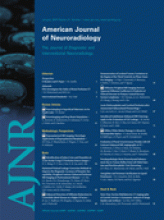Gliomatosis cerebri (GC) is a rare clinical entity characterized by diffuse and infiltrative overgrowth of tumor cells. The most commonly involved areas of GC are in the bilateral hemispheres, at least 2 lobes per hemisphere, and the infratentorial region.1 The neurologic involvement of Behcet disease ranges from 2.2% to 49%.2 We report a case of Neuro-Behcet disease (NBD) mimicking GC. There have been a limited number of case reports describing neurologic pseudotumoral presentation in NBD.3
A 38-year-old man was admitted to our clinic with mental status changes, deterioration of speaking and walking, oral and genital mucocutaneous ulcerations, and incontinence. His symptoms had existed for 1 month. On admission, tetraparesis was found on his neurologic examination. Regarding the MR imaging findings, we initially thought that the lesions supported GC (Fig. 1A). MR imaging spectroscopy and diffusion-weighted MR imaging (DWI) investigations did not support tumors (Fig 1B, -C). Eye lesions were not detected. Consultation with a dermatologist resulted in a diagnosis of NBD. Three months after the treatment, the neurologic status had substantially recovered, and the lesions were markedly reduced on MR imaging (Fig 1D).
A, T2-weighted image reveals high signal intensity in the mesencephalon, bilateral basal ganglions, posterior limb of the internal capsule, and centrum semiovale regions. B, ADC map reveals high signal intensity. C, MR spectroscopy reveals that major peaks are normal, excluding GC. D, T2-weighted images reveal markedly smaller lesions after treatment. Cr indicates creatine.
The differential diagnosis of NBD may be difficult, because NBD can mimic other neurologic disorders, particularly in areas in which the disease is uncommon. The most common lesions of NBD are located at the mesodiencephalic junction, followed by the pontobulbar region. The lesions are bilateral in approximately one-third of the cases, and hemispheric lesions are not commonly seen.2 Therefore, our case was mimicking GC in terms of the unusual location of these lesions. DWI is a useful tool for the differential diagnosis of NBD in distinguishing it from other disease, especially acute ischemic infarcts.3 A stereotactic biopsy is usually used to distinguish NBD from cerebral tumors. There are no published reports concerning the use of MR spectroscopy for this separation. DWI and MR spectroscopy may help in the neoplasms and demyelinating lesions.4 Apparent diffusion coefficient values are elevated for chronic lesions as in our case, though these values may be reduced for acute lesions in a demyelinating disease. The typical DWI features for primary neoplasms are variable. Typical MR spectroscopic features for primary neoplasms are elevated peaks of lipid, lactate, choline, and myo-inositol and reduced N-acetylaspartate signals. In our case, these features were not observed and MR spectroscopy findings were normal.4 After the treatment, the lesions significantly decreased. In conclusion, we suggest that MR spectroscopy and DWI should be used in the differential diagnosis of NBD to avoid unnecessary invasive approaches.
- Copyright © American Society of Neuroradiology













